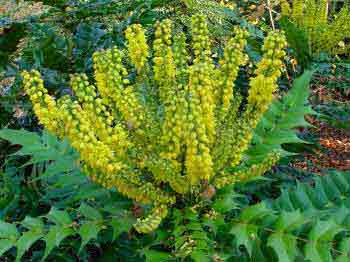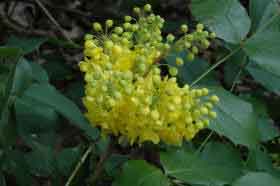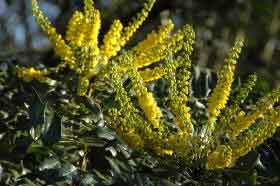Mahonia – Winter Flowering Evergreen Shrubs Care
Most gardeners either love or hate Mahonias. I most certainly fall into the former category for growing and photographing this range of plants has always given me great pleasure – especially on cold November days!
Mahonias are in the family Berberidaceae and as you might surmise from that, are related not too distantly to Berberis. Some of the tell-tale similarities include the make-up of the individual small flowers and in particular, the fact that just under their bark there is a bright yellow cambium layer or heartwood even.
Mahonia shrubs
basically fall into one of two groups – conveniently tall or short!
The taller varieties are typified by Mahonia x media ‘Charity’ types
and the shorter, more compact group by the Mahonia aquifolium groups.
Image of Mahonia x media 'Lionel Fortescue' ©
David Hughes
All the Mahonias we discuss here are flowering evergreen shrubs with yellow flowers – normally scented – which appear either in the winter or spring months. The flowers of all Mahonia plants are followed by dark purple or black berries (fruits) which are soon dispatched by hungry birds. Whether or not they are edible is a matter of taste – and uncertainty!
I f
they taste anything like the related Berberis berries that I tried as
a youngster they are best avoided, though there are recipes available
for various jams. Some are listed as being poisonous to the effect of
vomiting, lowering blood pressure etc if eaten in large
quantities. I would suggest that they could certainly cause stomach
upset if eaten raw in quantity. Best avoided!
f
they taste anything like the related Berberis berries that I tried as
a youngster they are best avoided, though there are recipes available
for various jams. Some are listed as being poisonous to the effect of
vomiting, lowering blood pressure etc if eaten in large
quantities. I would suggest that they could certainly cause stomach
upset if eaten raw in quantity. Best avoided!
The evergreen foliage is a gardener’s plus – sometimes striking, but always welcome. The taller types of Mahonia have long striking pinnate leaves atop the upright stems, whilst the shorter group – whilst attractive foliage and flowers have shorter individual pinnate leaves.
How to Grow Mahonias
Once you have chosen the correct planting position. It is very much a ‘plant and forget’ situation as far as immediate aftercare is concerned. That is not to say that general neglect is the order of the day, but Mahonias really are low maintenance shrubs.
The best planting position would be in semi shaded areas – dappled shade and full shade will also be acceptable for they are basically rocky or woodland plants from areas as disparate as the Himalayas, Eastern Asia – including the colder climates – and central to North America. The shorter Mahonias will tolerate sunny positions providing the soil does not totally dry out. Otherwise in the ideal shaded areas they will rarely if ever require additional watering – or feeding – after settling in during planting.
Be aware –as you soon will be – that the leaves can be rather spiky and be uncomfortable to brush against. This is particularly so with the taller growing types. That is not to say that the shorter varieties are cuddle. The leaves on all types are tough and leathery.
Early spring is the best time to plant, though summer will also be acceptable with container grown plants.
Dependent upon variety – do give space for them to grow either into tall specimens, shrub border inhabitants, specimen shrubs – or low groundcover plantations.


Mahonia aquifolium Apollo - Mahonia lomariifolia - Mahonia x media 'Charity' © David Hughes
Soil type for Mahonias
Most light to medium fertile soils including loams will suit. Heavy clay soil best avoided unless regularly dressed in the vicinity with copious annual mulches. Either slightly acid, neutral or even alkaline soils seem to be ok for all. I have grown them in woodland situations with a slightly acid mix and also on the chalk downs of Kent with no ill effects.
Problems with Mahonia
There are virtually no insect pests that affect Mahonias – mainly on account of their tough, leathery foliage being unpalatable for any sap suckers.
The main diseases – which only seem to affect the shorter Mahonia aquifolium types are varied leaf spots, Rust and powdery mildew. I have never encountered such problems with the taller Mahonia x media types. (after growing several thousand on a nursery, and planting many hundreds in public and private planting schemes.
Propagation of Mahonias
All types will grow quite readily from seeds sown in a cold frame as soon as they are ripe. Germination tends to happen later in the year. Stratification for a month in damp sand seems to aid germination.
All can be struck by various types of cuttings.
The larger types of Mahonia x media can be rooted by way of a short section of stem inserted into a pot and left over winter. Reduce the length of the long leaved down to just 4 leaflets.
The shrubby Mahonia aquifolium - Oregon Grape -can be best rooted by tip cuttings in the late summer placed in a cold frame.
Pruning Mahonia different types
Pruning Mahonia Shrubs
Best Selling Gardening Products
Popular Gardening Sections

Problems
Identify Weeds in The Garden - How to deal with weeds. Diseases and Pest which harm your garden and plants, learn how to prevent, deter and erradicate your garden problems.
Garden Problems
Pruning
Pruning Guide. Shrubs flower better with correct pruning. Many illustrations and examples of what to do - and when. Includes evergreens, roses, flowering shrubs, spring flowering shrubs and pruning for stem effect. This is our most viewed and comprehensive section,
Pruning
Gardening Businesses
Gardening Businesses listed in the UK counties and USA states. County and State Listings of businesses involved in Garden supplies and services. If you wish to be added to the Directory, please send us your information. Having problems, use the search box
Businesses
Gardening
In this section you will learn about Gardening Basics, Containers, Landscaping, Propagation and Soil.
Gardening
Gardening Gifts
Gardening Gifts and Reviews, Read Before you Buy
- Gardening Gifts Ideas
- Gifts For Her
- Gifts For Men
- Power Tool Gifts
- Cheap Gifts
- Personalised Gifts
- Wildlife Gifts
- Family Gifts




